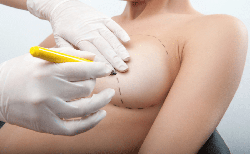Poltava, prospekt Vitaliia Hrytsaienka 9 Weekdays: 8:30-15:00, Weekend: weekend +38 (0532) 56-02-11+38 (095) 688 25 07
Breast asymmetry: causes and methods of treatment
 Any woman can have natural asymmetry of the breast. But in the normal state, the deviation is less than one size. If the difference in size and shape is expressed more evidently, it can bring great discomfort. There are several ways to correct the lack of proportion by reducing or increasing one of the mammary glands, resulting in complete harmony in the appearance.
Any woman can have natural asymmetry of the breast. But in the normal state, the deviation is less than one size. If the difference in size and shape is expressed more evidently, it can bring great discomfort. There are several ways to correct the lack of proportion by reducing or increasing one of the mammary glands, resulting in complete harmony in the appearance.
Causes of breast asymmetry
The disproportion can be congenital and progress during puberty, or acquired, which is associated with abnormalities in the body.
- Congenital asymmetry. Nature stipulates some asymmetry not only of the breast, but also of the feet, eyes, ears and other paired parts of the body. During lactation, the inherent disproportion of sizes and forms can be eliminated on their own, but the opposite effect is also possible, when the disproportion can become even more evident.
- Breastfeeding. If milk pools in one of the breasts, then later it can become larger.
- Plastic surgery for breast increasing. When the implant is displaced or fibrosis is formed, severe mammary deformity can arise.
- Hormonal changes. During puberty and menopause periods, an uneven tissue growth can be observed.
- Mastopathy. Benign and malignant neoplasms can lead to deformity and disproportion. To prevent the disease, you need to do mammograms regularly.
 Disorders caused by hormonal changes, pass independently or require drug treatment, in other cases, plastic repair may be performed, which will help to get a completely harmonious appearance.
Disorders caused by hormonal changes, pass independently or require drug treatment, in other cases, plastic repair may be performed, which will help to get a completely harmonious appearance.
Asymmetry types
Asymmetry of the mammary glands is classified by degree of severity. Minor changes within the same size do not create significant disharmony as to the appearance and do not require correction. The average degree implies an increase of one breast relatively to another by 1/3, and a severe degree assumes a difference in size by 1/2.
Also, the types of asymmetry are classified according to the type of changes:
- delay in development (hypoplasia) of one breast and normal development of the second;
- hypertrophy of one breast and normal development of the second;
- combination of hypoplasia and hypertrophy;
- uneven descent;
- difference in diameters of areola nipples.
The method of surgical intervention will be selected depending on the type of change.
Methods of surgical correction
If the patient has hypoplasia, a plastic surgery for breast increasing in case of insufficient size is performed using implants.
In case of hypertrophy, reduction mammoplasty is performed. Treatment involves dissection in the nipple area or submammary folds. After that, the excess glandular and adipose tissue is removed. Then, if necessary, the nipple is positioned in the desired area.
In case of different diameters of the nipple-areola area, a correction should be made. To do this, the areola is cut through the outline, the excess tissue is removed and the nipple is transferred to its place.
In case of different degrees of ptosis, mastopexy is performed. The treatment involves the removal of excess tissue with the help of incision in the area under the nipple or around it.
Surgical techniques are the only effective way to eliminate the disproportion of the mammary glands. Cosmetic procedures, masks and creams, massages and exercises cannot overcome this deficiency. With the help of plastic repair, you can eliminate any forms of asymmetry, if they are not associated with diseases and hormonal disorders. The first result can be seen after 6 months and it persists for life.
